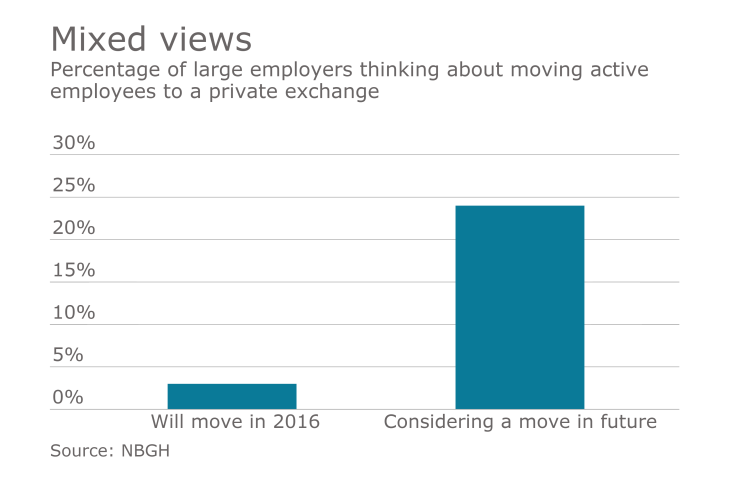Employees enrolled in a private exchange are, on average, five times more likely to purchase a product with a recommendation than without one, according to new research.
The Private Exchange Research Council analyzed data from 2013 to 2015 to determine which products employees purchased in Liazon-powered exchanges. Liazon operates private benefits exchanges for large and small businesses in the United States.
In 2015, U.S. employees bought 4.4 of the 7.4 recommended products, up from 3.7 of 7.2 products in 2014. Products were recommended by software.

For example, 87% of employees bought vision insurance when the private exchange recommended to do so, compared to 35% of employees who bought it without a recommendation. Similarly, employees were 17 times more likely to purchase child insurance and 21 times more likely to purchase pet insurance with a recommendation, according to the “Understanding Product Offerings and Choices on a Private Exchange” report.
See also:
While those are outliers, the purchasing rates of recommended products were at least two to four times higher than the same products without the recommendation.
An important takeaway, says Alan Cohen, chief strategy officer and co-founder of Liazon, is that companies are using the exchange as an opportunity to increase or expand benefit offerings.
Overall, the average number of products offered in PERC’s study has grown from 12.9 products in 2013 to 14.2 products in 2015.
About 8 million employees were enrolled in private health insurance exchanges in 2016, up from 6 million in 2015, according to a January report from professional services firm Accenture.
See also:
Baby boomers and Gen Xers — generally those who are married, are in poor health, are high users of medical or pharmacy plans or have financial issues — are most likely to buy products, according to PERC’s report.
Nearly 40% of baby boomers and 41.1% of Gen Xers bought between four and nine products in the exchange in 2015. Only 28.8% of millennials, however, purchased the same number of products.
Cohen noted that millennials under the age of 26 are covered by their parents’ health insurance under the Affordable Care Act, which could explain the lack of product purchases between generations in the exchange.
Despite millennials waiving their major medical, employees still view their healthcare as the cornerstone of the benefits package. And with changing plans and coverage, employees are looking to recommendations to help them make those decisions.
See also:
“The beauty of a good search engine is that it’s not just giving you choices, but gives people really good information,” says Barbara Gniewek, principal at professional services firm PwC. “Historically, we haven’t done that.”
The recommended plan is based on any recommendation the employee received and was matched based on same product ID, coverage tier and price, according to PERC.
Of the 86,186 employees who bought medical insurance in 2015 through Liazon-powered exchanges, 88% chose to go down the recommendation path.
Thirty-eight percent, or 28,531 employees, bought the recommended medical plan; 29 employees bought a different plan for the same price as the recommended option.
Thirty-one percent of employees (23,453) bought a more expensive plan, while a very similar number of employees (23,633) bought a less expensive plan.
For those who spent less than the recommended plan, single employees saved $2,735 while employees with dependents saved $4,049 on average. Single employees spent about $1,069 more than the recommended medical plan while employees with dependents spent about $3,132 more.
“The biggest complaint is that in private exchanges people are buying down,” says Christopher Condeluci, principal, CC Law & Policy PLLC.
See also:
He points to PERC’s data as proof that fear is unsubstantiated.
Another challenge with private exchanges is that employees purchase healthcare based on their perception of risk rather than actual risk, says Eric Helman, chief strategy officer at Hodges-Mace, LLC, an employee benefits technology firm.
“Decision-support engines most often accelerate the trade down of insurance,” he says. “When given multiple choices, people buy less insurance in the form of major medical.”
Employers seem to be aware of that trend.
PERC noted that the same set of companies increased their ancillary product offerings from 2014 to 2015. The growth was greatest for hospital indemnity (+90.3%), critical illness (78.6%) and accident (56.9%) insurance.
“Healthcare consumerism today tends to talk about the consumption of healthcare and the real domain of consumerism is at the point of purchase of the benefit,” Helman says.





